"When Croydon Bourne doth upwards ryse, disaster dyre before us lyes". (Camden's Britannia 1586)
The Bournes or Woe Waters are intermittent streams that supplement the water supplies of the River Wandle. They originate from the ancient dedritic catchment of the river on the North Downs and occur as seasonal springs in the Caterham and Couldsdon valleys that merge at Purley. From Purley the flow is now culverted to Croydon where it picks up the named River Wandle at the Swan and Sugarloaf. The Bournes were known as Woe Waters due to the disconcerting tendency in exceptionally rainy conditions to flood and bring disease and crop failure.
PURLEY
In the past Purley has been noted as a tram link terminus for the historic double decker trams that once ran north along the Brighton Road to Croydon. It was also the location of a water pumping station on the site that is now a supernmarket. Associated with the waterworks pumping station was a publc fountain facility that included a drinking spout, decorative fountain and cattle trough as pictured below. They were located on the junction of the main roads from Caterham, Coulsdon and Croydon. This was known as Purley Cross and the fountain dates from 1905. Only the decorative fountain survives. In the twentieth century it was relocated to the grounds of the pumping station to make way for traffic/road enhancements. Later is was relocated again to the grounds outside Purley Library. Here it is visible from the one way traffic system at this major route intersection.
There are now plans afoot to restyle the junction yet again and it is hoped that the fountain will be restored to a position that shows off its elegance.
The fountain was erected in memory of Queen Victoria on 22 January 1901.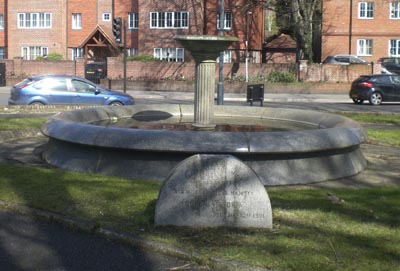 The man standing on the left has the plaque that survives before him with a drinking fountain behind it. The trough is supplied by the Metropolitan Drinking Fountain and Cattle Trough Association.
The man standing on the left has the plaque that survives before him with a drinking fountain behind it. The trough is supplied by the Metropolitan Drinking Fountain and Cattle Trough Association.
The fountain in its present day position on the one way traffic flow system
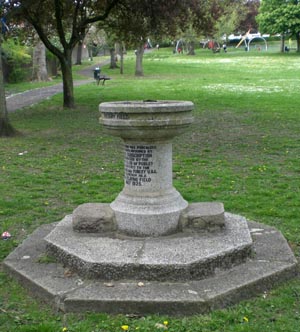 Another fountain just north of Purley lies on the line of the ancient Croydon, Godstone and Merstham iron railway. It also lies on the line of the feeder from the Bournes to the River Wandle at the Swan and Sugarloaf. Opposite Christ Church on the main Purley - Croydon road there is a recreation area know as Rotary Field. A fountain exists here that records the creation of this facility. The caption on the granite fountain reads "This ground was purchased from funds obtained by public subscription inaugurated by the Rotary Club of Purley and conveyed to the Coulsdon and Purley UDC to maintain as a public playing field July 1925". Unfortunately the fountain is dry but retains its original dignity and charm in an area that continues to provide leisure facilities.
Another fountain just north of Purley lies on the line of the ancient Croydon, Godstone and Merstham iron railway. It also lies on the line of the feeder from the Bournes to the River Wandle at the Swan and Sugarloaf. Opposite Christ Church on the main Purley - Croydon road there is a recreation area know as Rotary Field. A fountain exists here that records the creation of this facility. The caption on the granite fountain reads "This ground was purchased from funds obtained by public subscription inaugurated by the Rotary Club of Purley and conveyed to the Coulsdon and Purley UDC to maintain as a public playing field July 1925". Unfortunately the fountain is dry but retains its original dignity and charm in an area that continues to provide leisure facilities.
CROHAM HURST FOUNTAIN
A trip to nearby Croham Hurst reveals the site of yet another similar drinking fountain. Croham Hurst is a public recreation area now largely woodland that lies to the east of the A23 Purley to Croydon Road. The site dates back to 1901 when after three years of local campaigning by residents against development, the Whitgift Foundation sold the 34 hectares of land to the Croydon Corporation. The drinking fountain likely dates from around this time.
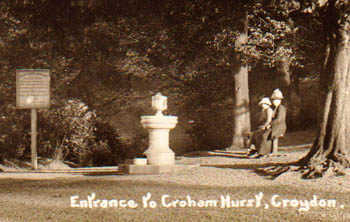
The land rises over the chalk with overlying Thanet Sands and there is evidence of early man from 3000-5000 BC inhabiting the 477 foot hill. Over the years the area has become wooded and is now an interesting wildlife reserve as well as public park. There are eleven assorted entrances, the most easily accessible being on the Upper Selsdon Road. The fountain was located by an entrance where a sign read "County Bord of Croydon", followed by a notice of prosecution should anyone damage the locality and signed by the Town Clerk F C Lloyd. This enables the photograph right to be dated to around the first decade of the 20th century. The fountain is believed to have been lost, or did it end up in Wandle Park Croydon (see 2. Croydon below)? If you know what happened email us wandle@thespas.co.uk
CHIPSTEAD VALLEY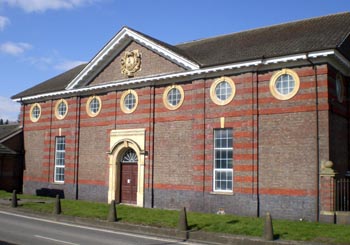
Picture: The 1907 Sutton District Water Company pumping station at Woodmansterne in the Chipstead branch of the Wandle catchment valleys.
There were two particular problems that had to be addressed as the infrastructure of the water supply industry developed in the 19th and 20th centuries. The first was the effect that boring new wells had on the historic water resources. Did excessive pumping reduce water flow elsewhere? The second was the problem of contamination. Were contaminated deep wells able to pollute others due to the presence of underground water pathways through fissures in the chalk? By draining the water table in one area, did underground water then move into the void? This would be a problem if poor quality surface 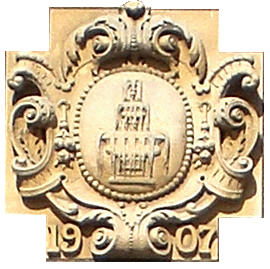 water and sewerage contaminated the water table as the population and building development expanded. In the case of Woodmansterne the well bored was yielding a large water supply from the Upper and Middle Chalk. The Sutton Water Company had sunk two well borings in 1905. They were 3 feet in diameter and 60 feet apart, about half a mile from Chipstead Railway Station. They were 450 feet in depth and lined for the first 100 feet. Combined the two bores yielded one and a half million gallons in 24 hours and in 1909 were averaging 320,029 gallons a day. Known as the number 1 well this source became notable for its supply.
water and sewerage contaminated the water table as the population and building development expanded. In the case of Woodmansterne the well bored was yielding a large water supply from the Upper and Middle Chalk. The Sutton Water Company had sunk two well borings in 1905. They were 3 feet in diameter and 60 feet apart, about half a mile from Chipstead Railway Station. They were 450 feet in depth and lined for the first 100 feet. Combined the two bores yielded one and a half million gallons in 24 hours and in 1909 were averaging 320,029 gallons a day. Known as the number 1 well this source became notable for its supply.
CATERHAM VALLEY
Jubilee Fountain - The horse trough and drinking fountain on the Caterham Road at Purley celebrate the availability of fine drinking water for those using the road in the late 19th century. The text on the plaque is now almost impossible to decipher - THIS FOUNTAIN WAS ERECTED BY THE PARISHIONERS OF COULSDON TO COMMEMORATE THE JUBILEE OF THE GLORIOUS REIGN OF HER MAJESTY QUEEN VICTORIA AD 1897. (Coulsdon included Purley and Kenley) The water feature once had gas lamps overhead.
Picture - The Jubilee Fountain outside Oakwood School, Purley on the Caterham Road.
At the Kenley waterworks in the Caterham Valley another problem arose when water extraction started in the nineteenth century. The water needed to be softened and this meant large quantities of lime had to be disposed of. At Kenley, the East Surrey Company dumped the precipitate on low lying ground near the works. At their Purley works it was disposed of in an old gravel pit. Such measures inevitably would not last long and in the early 20th century new uses were desparately sought for the lime. In addition the pumping at Kenley, Purley and Croydon was blamed for lowering the water table. Consideration was given as to how this would affect the Bourne Waters.
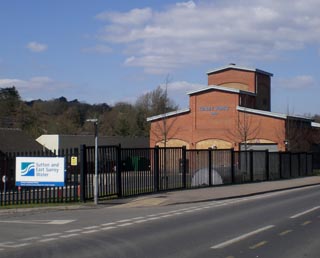
The conclusion was that whilst the seasonal waters in the valley could well be reduced by the pumping, excessive seasonal rainfall meant it would not curtail the flow of the Bourne. It was added that the outbreak of the Bourne was by no means a blessing, or if it was, a much disguised one. It was also pointed out that the population had expanded up into the attractive valleys and chalk hills and this would not have been possible without a good pumped water supply.
Picture - The Kenley Water Treatment Works of the Sutton and East Surrey Water on the course of the Bourne Water. This modern works dates from 1989 replacing much earlier works.
At Kenley the East Surrey Waterworks had four wells bored. All were lined to a depth of 100 feet with caste iron cylinders out of total depths of 250, 350, 308 and 353 feet respectively. The first was made in 1873 and enlarged in 1883. The second 1884, the third in 1891 and the fourth made in 1895. The rest level of the water was about 48 feet down. It was found that pumping at 1.44 million gallons a day lowered the water level by about 20 feet.
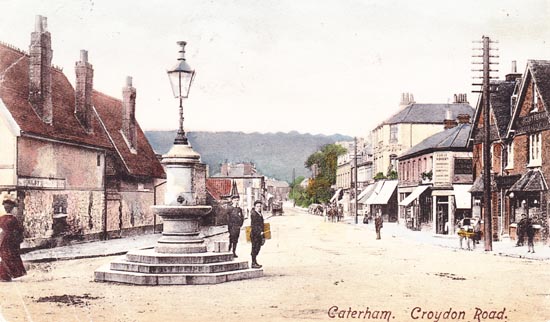
Asprey Fountain - At the head of the valley from Purley lies Caterham. In 1905 the granite fountain illustrated was in the centre of the main street where there is now a roundabout near the station. Such a fountain would only have been possible with a good supply of refreshing mains water, pumped up from the wells lower down the valley. In 1890 Charles Asprey donated the drinking fountain. It was removed to White Knobs Sports Ground in 1933 and it now takes pride of place in Church Walk. Charles was a founding director of the Caterham and Kenley Gas Company, who provided the gas for the original lamp, which was on top of the fountain and Caterham's first street light. Born in Mitcham in 1813, he became a Bond Street Jeweller, coming to Caterham in the 1860's and living in Stafford Road. His imposing tomb can be seen in St Mary's Churchyard nearby.
Caterham Waterworks Company was a local venture by the principal land owner. At a cost of more than twelve thousand pounds the waterworks and up to seven miles of distribution mains were built. Caterham was a potential good water source as was proved by a trial well in 1859. Three new wells were bored in the 19th century by the local water company. They were each about 880 feet deep and dated between 1861 and 1878. The wells were sited near and under an engine pumping house with four reservoirs located on a hill about three quarters of a mile south of the village of Caterham. 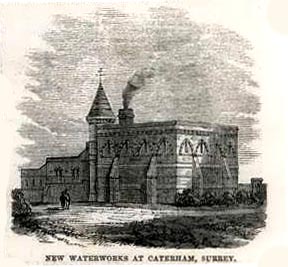 The wells yielded a quarter of a million gallons a day. As a result, from 1861 the Caterham Waterworks Company was supplying water to the surrounding areas. Then a case of fever occurred and this quickly spread over a wide area albeit confined to individuals who had consumed Caterham water. At the time the new wells were still being dug and although turbidity was a short term problem, no contamination other than that was problematic, or so they thought. During the boring operations it was noted that waste water escaped back to the other wells in spite of being discharged some distance from the wells. Finally, after much investigation, pollution was shown to have arisen from a workman who had diarrhoea. He had been driving an adit underground and the bucket for his ejectamenta had been spilt accidentally. As a result enteric fever was introduced into the water supply. This spread via pipelines to distant areas and by the end of February 352 people had experienced the disease. Unfortunately 21 of these proved to be fatal. Remedial action resulted in the Caterham Company being absorbed by the East Surrey Company and the particular wells were abandoned.
The wells yielded a quarter of a million gallons a day. As a result, from 1861 the Caterham Waterworks Company was supplying water to the surrounding areas. Then a case of fever occurred and this quickly spread over a wide area albeit confined to individuals who had consumed Caterham water. At the time the new wells were still being dug and although turbidity was a short term problem, no contamination other than that was problematic, or so they thought. During the boring operations it was noted that waste water escaped back to the other wells in spite of being discharged some distance from the wells. Finally, after much investigation, pollution was shown to have arisen from a workman who had diarrhoea. He had been driving an adit underground and the bucket for his ejectamenta had been spilt accidentally. As a result enteric fever was introduced into the water supply. This spread via pipelines to distant areas and by the end of February 352 people had experienced the disease. Unfortunately 21 of these proved to be fatal. Remedial action resulted in the Caterham Company being absorbed by the East Surrey Company and the particular wells were abandoned.
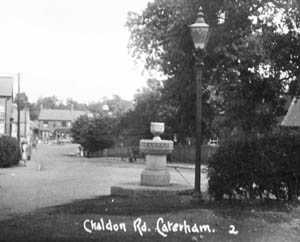
Picture above - The Waterworks included a steam pumping engine and was designed by Richard Drew of Pall Mall East. Clarke's water softening process ensured soft water.
There is another drinking fountain that once existed at Upper Caterham. It was in Chaldon Road on the junction with Westway. The design is similar to the fountains in Wandle Park, Croydon and Croham Hurst above suggesting similar dating. Little is known about this fountain which has long disappeared. Interestingly, there is the remains of a rescued, red stone horse trough on the forecourt of the library across the road.
Picture above supplied by East Surrey Museum, Caterham. For more details of the public water supply to Caterham and Kenley read "Many a Drop to Drink - A brief history of the Sutton and East Surrey Water Company" by Dorothy Hill in Local History Records 37. 1998 The Bourne Society, p.36.



 Springs, Spouts, Fountains and Wells of the River Wandle - 6
Springs, Spouts, Fountains and Wells of the River Wandle - 6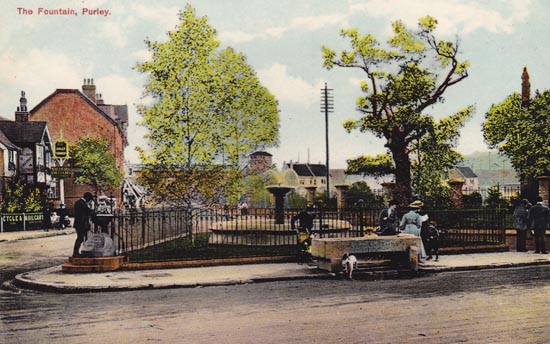
 The man standing on the left has the plaque that survives before him with a drinking fountain behind it. The trough is supplied by the Metropolitan Drinking Fountain and Cattle Trough Association.
The man standing on the left has the plaque that survives before him with a drinking fountain behind it. The trough is supplied by the Metropolitan Drinking Fountain and Cattle Trough Association. Another fountain just north of Purley lies on the line of the ancient Croydon, Godstone and Merstham iron railway. It also lies on the line of the feeder from the Bournes to the River Wandle at the Swan and Sugarloaf. Opposite Christ Church on the main Purley - Croydon road there is a recreation area know as Rotary Field. A fountain exists here that records the creation of this facility. The caption on the granite fountain reads "This ground was purchased from funds obtained by public subscription inaugurated by the Rotary Club of Purley and conveyed to the Coulsdon and Purley UDC to maintain as a public playing field July 1925". Unfortunately the fountain is dry but retains its original dignity and charm in an area that continues to provide leisure facilities.
Another fountain just north of Purley lies on the line of the ancient Croydon, Godstone and Merstham iron railway. It also lies on the line of the feeder from the Bournes to the River Wandle at the Swan and Sugarloaf. Opposite Christ Church on the main Purley - Croydon road there is a recreation area know as Rotary Field. A fountain exists here that records the creation of this facility. The caption on the granite fountain reads "This ground was purchased from funds obtained by public subscription inaugurated by the Rotary Club of Purley and conveyed to the Coulsdon and Purley UDC to maintain as a public playing field July 1925". Unfortunately the fountain is dry but retains its original dignity and charm in an area that continues to provide leisure facilities.

 water and sewerage contaminated the water table as the population and building development expanded. In the case of Woodmansterne the well bored was yielding a large water supply from the Upper and Middle Chalk. The Sutton Water Company had sunk two well borings in 1905. They were 3 feet in diameter and 60 feet apart, about half a mile from Chipstead Railway Station. They were 450 feet in depth and lined for the first 100 feet. Combined the two bores yielded one and a half million gallons in 24 hours and in 1909 were averaging 320,029 gallons a day. Known as the number 1 well this source became notable for its supply.
water and sewerage contaminated the water table as the population and building development expanded. In the case of Woodmansterne the well bored was yielding a large water supply from the Upper and Middle Chalk. The Sutton Water Company had sunk two well borings in 1905. They were 3 feet in diameter and 60 feet apart, about half a mile from Chipstead Railway Station. They were 450 feet in depth and lined for the first 100 feet. Combined the two bores yielded one and a half million gallons in 24 hours and in 1909 were averaging 320,029 gallons a day. Known as the number 1 well this source became notable for its supply.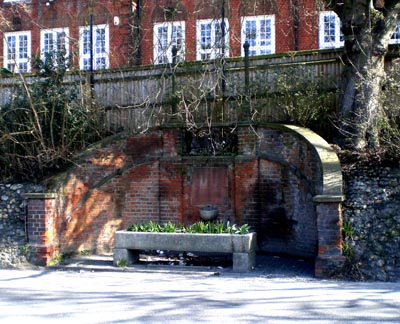


 The wells yielded a quarter of a million gallons a day. As a result, from 1861 the Caterham Waterworks Company was supplying water to the surrounding areas. Then a case of fever occurred and this quickly spread over a wide area albeit confined to individuals who had consumed Caterham water. At the time the new wells were still being dug and although turbidity was a short term problem, no contamination other than that was problematic, or so they thought. During the boring operations it was noted that waste water escaped back to the other wells in spite of being discharged some distance from the wells. Finally, after much investigation, pollution was shown to have arisen from a workman who had diarrhoea. He had been driving an adit underground and the bucket for his ejectamenta had been spilt accidentally. As a result enteric fever was introduced into the water supply. This spread via pipelines to distant areas and by the end of February 352 people had experienced the disease. Unfortunately 21 of these proved to be fatal. Remedial action resulted in the Caterham Company being absorbed by the East Surrey Company and the particular wells were abandoned.
The wells yielded a quarter of a million gallons a day. As a result, from 1861 the Caterham Waterworks Company was supplying water to the surrounding areas. Then a case of fever occurred and this quickly spread over a wide area albeit confined to individuals who had consumed Caterham water. At the time the new wells were still being dug and although turbidity was a short term problem, no contamination other than that was problematic, or so they thought. During the boring operations it was noted that waste water escaped back to the other wells in spite of being discharged some distance from the wells. Finally, after much investigation, pollution was shown to have arisen from a workman who had diarrhoea. He had been driving an adit underground and the bucket for his ejectamenta had been spilt accidentally. As a result enteric fever was introduced into the water supply. This spread via pipelines to distant areas and by the end of February 352 people had experienced the disease. Unfortunately 21 of these proved to be fatal. Remedial action resulted in the Caterham Company being absorbed by the East Surrey Company and the particular wells were abandoned.




